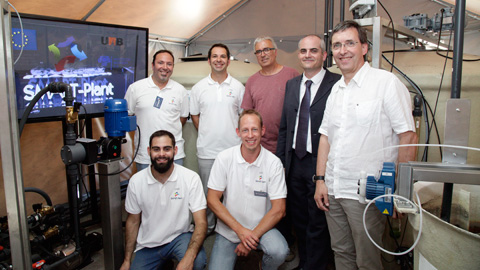Pioneering Technology Could Transform Treatment Plants into Biorefineries

22/06/2017
The GENOCOV research group at the Universitat Autònoma de Barcelona (UAB) and Aigües de Manresa S.A. Empresa Municipal inaugurated today a pilot wastewater treatment plant in Manresa which generates added value products during the treatment process.
This pilot plant, built under the framework of the European SMART-Plant project, will demonstrate the functioning of a new technology developed by UAB researchers which improves the efficiency of urban sewage treatment while at the same time concentrating and extracting up to 50% of the phosphorus present, and recovering part of the organic matter to be used as raw material for the manufacturing of bioplastics (PHA precursors).
The technology, which has been named “Mainstream SCEPPHAR (Short-Cut Enhanced Phosphorus and PHA Recovery)”, is a pioneering system capable of transforming wastewater treatment plants (WWTP) into small biorefineries, thus helping the sector move towards a circular economy scenario.
The pilot plant where the new SCEPPHAR process will be implemented is located at the wastewater treatment plant of Manresa-Sant Joan, near Barcelona, and is designed to treat some 10 m3 of wastewater per day, following the most restrictive regulations.
The recovery of phosphorus is essential given that the nutrient is becoming scarcer and without it, there can be no sustainable agricultural production. Microorganisms concentrate the phosphorus found in the water and through a controlled precipitation reaction it is converted into struvite, a slow-release fertiliser highly valued in agriculture. The process needs no external sources of carbon or ferric chloride, two elements which are necessary to eliminate phosphorus in conventional treatments. Moreover, the SCEPPHAR system lowers operating costs by 25% because 90% of the nitrogen is eliminated through nitrite, a process which reduces the needs of aeration. Another improvement is the use of the sludge produced from the treatment process, which can contain up to 30% of polyhydroxyalkanoate precursors (PHA) and can later be used to produce bioplastics for industrial applications.
The European SMART-Plant project (Grant agreement no. 690323), with a duration of 4 years and an investment of €9,768,806.09, is made up of 26 partners (companies and universities) from 10 EU countries and is an Innovation Action of the H2020-WATER-1b-2015 programme. The global objective of the project is to upscale and demonstrate eco-innovative solutions to modernise existing wastewater treatment plants in real surroundings. During the project up to nine pilot plants will be tested out in five different treatment plants with the aim of improving the process, making them more energy efficient, reducing greenhouse gas emissions and recover resources. The resources recovered (biopolymers, cellulose, fertilisers and intermediate products) will be processed until they are transformed into salable products.
It is estimated that by using the technologies developed in this project, the existing wastewater treatment plants can be upgraded with an initial investment of 15 to 20 Euros per inhabitant, with an annual profitability through potential accumulative savings of 17 to 18 Euros per inhabitant. This high economic profit could revolutionise the sector in few decades, transforming treatment plants from net energy and resource consumers to producers of valuable materials.